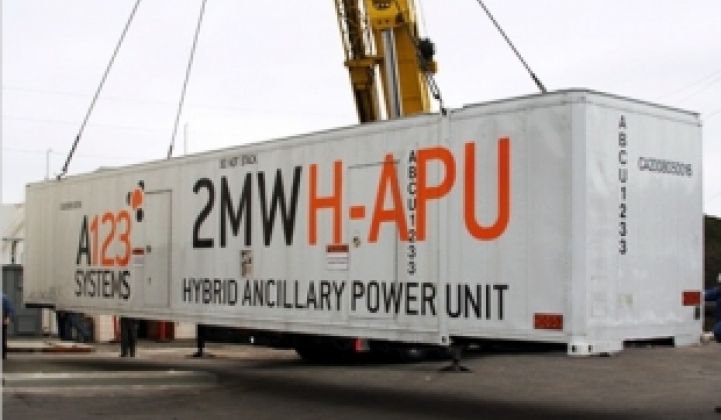“Honestly, utilities don’t understand how to use the [energy storage] product. Learn with them. That is what we are looking for,” said Stan Blazewicz, a Vice President and Global Head of Technology at National Grid. “Get past the PowerPoint slides and [show us] what you are willing to put into the partnership.”
At the MIT Energy Conference, National Grid and A123 agreed that it is essential for energy storage startups to see utilities as long-term partners, not merely as short-term customers through which to hit quarterly or yearly sales targets.
“When we talk to startups that have a way to go, [we ask] ‘Are they coming along for the ride with us or do they have a black box?’” said Blazewicz. “As opposed to vendors that [just] say ‘We understand what your problem is,’ [A123] will bring [folks] that understand our language and how they can solve our problems.”
“When we sit down with the utility, they want to know how storage works. [They ask] ‘Will you work with us?’” said Chris Campbell, Vice President of Marketing and Business Development for A123 Grid Storage. “We have two PhDs on staff who do nothing but MATLAB. They sit with utilities and map [projects] out. We are not afraid [to find out] that a particular project or application may not work, but then we have a relationship with the utility.”
But only the more progressive utilities -- think EDF in France or Enel in Italy -- are open to developing relationships with energy storage companies.
“Utilities, since facing restrictions in the 1990s, have been managing costs as much as we can. When it comes down to it, longer-term initiatives are put on the back burner,” said Blazewicz. “In many cases, [A123] will come to a [U.S.] utility and won’t know who to talk to because there is nobody to talk to. Outside of the U.S., in the U.K., we are allowed to spend on innovation and take risks with companies.”
The challenge for energy storage isn’t just on the utility side. Startups need to focus on particular problems.
“Identify what the problem is that you are trying to solve. People end up developing technologies, but they never tell you the attributes of the problem and how the technology can [address] those attributes,” said Mark Johnson, the director of ARPA-E’s Grid-Scale Rampable Intermittent Dispatchable Storage (GRIDS) program.
Over time, utility installations will begin to address longer-duration attributes.
“As the price points come down, one of the areas that looks promising is peaker replacement,” said Campbell. “To date, most of our installations have been relatively short-duration. The market is moving toward longer-duration and multi-hours. That is captured in the deployments that will take place this year.”
But quantifying the value of storage’s diverse benefits will take time and require regulatory clarity.
“We’ve looked at the business case for energy storage. There are value streams that could come into a particular energy storage project,” said Blazewicz. “The challenge that we face is that the technology is a square peg being shoved into a round hole. Fundamentally, it is difficult to capture all of the value.”
“The concern is about cross-subsidization,” said Bob Hellrich-Dawson, an economist at FERC’s Office of Energy Policy and Innovation. “You don’t want to see a storage resource paid from a rate base to subsidize a non-rate base benefit.”
Another often-overlooked challenge for energy storage is balance of system costs.
“For a spinning reserve application, the batteries make up 65 percent of the cost of the system. A lot of the cost is in power electronics,” said Campbell. “Is it reasonable that lithium-ion battery prices will [decrease] by a third by 2017? It is possible, but it will not [fully translate] to the cost of the system. When you get into a grid-scale storage system, you have racks of batteries, but the balance-of-system costs are significant.”
Nonetheless, energy storage’s long-term future is bright.
“The changes that are coming will strengthen the value proposition for energy storage,” said Blazewicz. “Right now, you have a system that is flexible. Generation can ramp up and down. But you need to site where the wind is. We are going to lose flexibility over the next 30 years. Carbon capture and sequestration is another technology that is hard to ramp up and down. The grid [of the future] will have less flexibility.”
***
Yoni Cohen has worked for venture capital firms DBL Investors and Israel Cleantech Ventures and reported about environmental innovation for numerous publications. Follow Yoni on twitter @Cohen_Yoni.
Batteries, Storage & Fuel Cells

National Grid to Storage Startups: Don’t Sell, Cooperate
There is a time for PowerPoint slides and a time for partnerships.

National Grid to Storage Startups: Don’t Sell, Cooperate
-
41Where Will DOE’s Loan Program Make the Next Climate Tech Investments?
-
15What the Frack Is Happening With Natural Gas Prices?
-
9With an Energy Crisis Brewing, No Peak in Sight for Emissions


